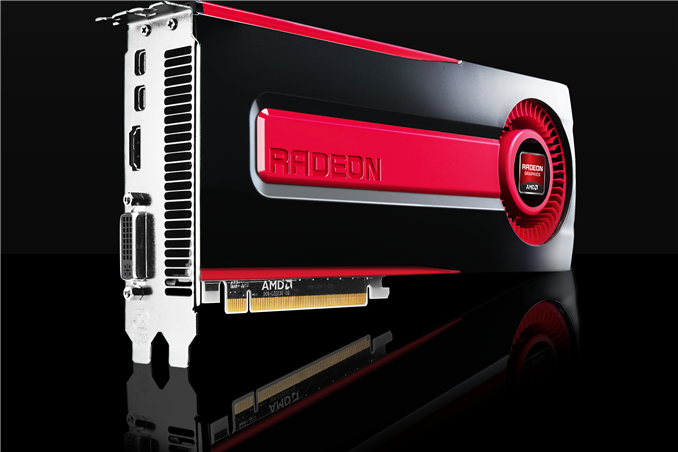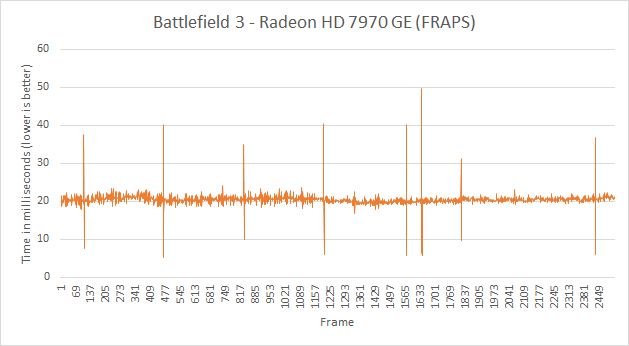AMD Comments on GPU Stuttering, Offers Driver Roadmap & Perspective on Benchmarking
by Ryan Smith on March 26, 2013 2:28 AM EST
For as long as I can remember talking about video cards and GPU performance at AnandTech, there has been debate over the type of benchmarks used to represent that performance. In the old days, the debate was mostly manufacturer driven. Curiously enough, the discourse usually fired up when one manufacturer was at a significant deficit in GPU performance. NVIDIA made a big deal about moving away from timedemos and average frame rates during the early GeForce FX (NV30) days, when its cards might have delivered a decent gaming experience but were slaughtered in most benchmarks. Even Intel advocated for a shift away from most CPU bound gaming benchmarks back during the early years of the Pentium 4 - again, for obvious reasons.
It’s a shame that these revolutions in gaming performance testing were always associated with underperforming products (and later dropped once the product stack improved in the next generation or two). It’s a shame because there has always been merit in introducing additional metrics in order to provide the most complete picture when it came to gaming performance.
The issue lay mostly dormant over the past several years. Every now and then there’d be a new attempt to revolutionize GPU performance testing, but most failed to gain widespread traction for one reason or another. Broad repeatability, one of the basic tenets of the scientific method, was usually cast aside in pursuit of a lot of these new attempts at performance testing - which ultimately limited acceptance.
A year and a half ago, Scott Wasson over at the Tech Report did something no one since Dr. Pabst was able to do: he actually brought about a revolution in the 3D game benchmarking scene.
The approach seemed ridiculously simple - we’ve all had the tools for so very long. Scott used FRAPS to record frame times, and would calculate how long every frame in a benchmark took to render. By focusing on individual frame latencies, Scott’s method could better characterize the little hiccups and stutters that would get smoothed out in an average frame rate. With the new method came a bunch of nifty graphs, and the world changed.

The methodology wasn’t perfect, as FRAPS lacks a holistic view of the 3D rendering pipeline, but it did reveal some surprising issues (in addition to spawning further work that uncovered even more issues on the multi-GPU front). Interestingly enough, many of the issues uncovered by this focus on frame times/latency seemed to primarily impact AMD hardware.
AMD remained curiously quiet as to exactly why its hardware and drivers were so adversely impacted by these new testing methods. While our own foray into evolving GPU testing will come later this week, we had the opportunity to sit down with AMD to understand exactly what’s been going on.
Although neither strictly a defense nor merely an explanation of what we’ve been seeing over the past year, AMD wanted to sit down and better explain their position. This includes both why AMD’s products have been impacted in the manner they were, and why at the same time (and not unlike NVIDIA) AMD is worried about FRAPS being given more weight than it should be. Ultimately AMD believes that it’s to the benefit of buyers and journalists alike to better understand just what is happening, why it’s happening, and just what the most common tools can and are measuring.
What follows is based on our meeting with some of AMD's graphics hardware and driver architects, where they went into depth in all of these issues. In the following pages we’ll get into a high-level explanation of how the Windows rendering pipeline works, why this leads to single-GPU issues, why this leads to multi-GPU issues, and what various tools can measure and see in the rendering process.










103 Comments
View All Comments
JPForums - Tuesday, March 26, 2013 - link
Their stance wasn't "Everyone else stutters so why should we bother with it." It was closer to "Everyone else stutters and we have no more control over it that they do ... Wait, you're saying they don't stutter as bad as we do ... and fixing our stutter would've actually helped our performance. Aw, nuts." I agree with Spoelie, it was ineptitude, not ill-will.extide - Wednesday, March 27, 2013 - link
You make absolutely no sense.Galidou - Saturday, March 30, 2013 - link
Lots of people seem to think AMD does so much mistakes that everytime it happens the world speaks about it more intensely because they actually admit it instead of trying to HIDE things, they even let the sites like anandtech make reviews on their problem. Right now, at home, I have two very comparable systems based on overclocked SNB. One with a 7950, and the other with a gtx 660 ti. Both play games extremely well but I have more trouble with my 660 ti. I get lots of ''Display adapter has stopped responding'' while surfing the internet, when waking up from long idle states and when playing League of Legends. I switched drivers, did clean install and I can't get rid of it totally. No my card is not overclocked and I can make it furmark all day long without a problem.I decided to play on my girlfriend's computer(which has the 7950) when I play league of legends because you just can't be interrupted in this kind of game. It even froze in LoL a couple times, at first I thought it was my SSD but after reading the dump files, found out it was the 660 ti. But hey, Nvidia is perfect(we just don't see them speaking of their problems that's it)... 4 months of it now, thanks alot... I wrote on nvidia forums did my research did everything they told me. Good thing it's only with LoL, internet and long idles, everything else runs flawlessly.
HisDivineOrder - Tuesday, March 26, 2013 - link
Actually, I think you should reread the article. It's true that fixing these stuttering issues has given them some frame rate improvements, but the article seemed relatively clear on the point that they were focused on frame rates and not frame latency or frame interval or whatever they're choosing to call it today.They had all their focus on one aspect of driver development and that actually cost them in that area because they weren't considering a more well-rounded approach.
I'll grant you AMD was pretty inept though. This has been problem they've had for years and it's taken them this long to suss it out...
piroroadkill - Tuesday, March 26, 2013 - link
Hey, what about PC Perspective: http://www.pcper.com/reviews/Graphics-Cards/Frame-...Looks to me as being the best way to measure it, as it uses a DVI capture card to actually capture what the user sees, forgoing any overhead software may have..
Rick83 - Tuesday, March 26, 2013 - link
Yes, that is the correct way to measure frame time.KikassAssassin - Tuesday, March 26, 2013 - link
Yeah, their method looks like the best of both worlds. It gets around the limitations of FRAPS without the complexity and difficulty of using GPUView.Anand Lal Shimpi - Tuesday, March 26, 2013 - link
The ideal method would be something that gives us timestamps at both ends of the pipeline, but that's a tall order. The PCPer method is very interesting indeed... ;)Mopar63 - Tuesday, March 26, 2013 - link
First very informative article. The issue at hand is that this so called concern is based on an individuals perception. Remember we are not talking about a stuttering that was so bad as to be noticeable to all gamers. Scott basically had to make a video specifically designed to point out the issue for others to see it originally.Because there is no real way to quantify the personal experience we have an issue in the fact that we now have a measurement craze that is being treated as fact when it is based in the end on subjection for the final result.
Having access to various levels of AMD and NVidia based machines I can tell you that my gaming experience across them has been pretty uniform in most cases. The cases when I had a bad experience, probably a wash as they are on both platforms.
I think the biggest issue is we sometimes get to caught up in the technology. We let benchmarks and measurement programs dictate to us what we will get the most enjoyment from with our gaming experience. A game is not the frame rates but the play that matters. While frame rates might play a roll it is not the measurement of them that makes that part of the fun.
At the end of the day the single best test of a video card is not a benchmark suite or tool to measure frame rendering time. The best tool is to play the games you want and see if you get the game experience you desire. Turn off the benchmark and turn on the game, that is the ONLY true test of what is best.
HisDivineOrder - Tuesday, March 26, 2013 - link
Speak for yourself. I've noticed this problem between nVidia vs AMD for years. For many years, gamers have said that nVidia cards are "smoother." People didn't listen because they didn't want to hear the truth or because they were likely stuck with one high end from AMD and a low end or medium end from nVidia.But comparing equivalent cards, I can tell you my experience has always led inescapably to the "feeling" that the nVidia card is smoother at the same or even slightly lower frame rate.
This just proves what I "felt" was the case was in fact really the case. If you didn't see it, then that's a fail on the part of your visual acuity or perhaps you had a bias you wanted to see, so you saw less than everything present.
But the stutter was always there. Now even AMD admits it.